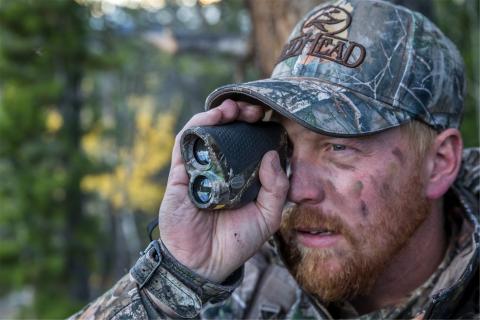
The laser rangefinder may be the most underrated of all the optical tools for hunters. Yet there are many hunting situations in which a rangefinder will make you a better shot with a bow, rifle, or shotgun. It’s an important scouting tool, too.

A rangefinder can be used actively or passively. Active use includes sighting the rangefinder on the animal or bird you are considering shooting. Passive rangefinder uses include ranging to various objects and committing those distances to memory to allow you to more accurately estimate the range when a potential target approaches.
If a rangefinder is to be used actively, particularly for hunting big game, speed, simplicity, reliability, and one-hand-usability are all important features.
At bowhunting, slug hunting, and muzzleloading ranges, deer and other big game animals won’t let you get away with much. So quick ranging with a minimum of movement is critical.
Using Rangefinder for Field Hunting Waterfowl

for sighting an animal or bird you are considering
shooting or ranging to various objects so you can
accurately estimate the range when a target approaches.
One active use that’s underutilized is for waterfowl hunting, particularly field hunting. When hunting with partners, take turns behind the rangefinder calling out distances as birds approach. Lock on a bird in the flock and call out 20 yard increments … “200, 180 … 100, 80, 60, 40, TAKE ‘EM!” If all the hunters cooperate, you’ll be amazed at how much everyone’s shell to limit ratio will improve.
You’ll also hone instinctive range estimation skills by refining your mental picture of how birds appear at different ranges.
For this purpose, select a rangefinder built on golfing technology that locks the laser on small targets. On the golf course it’s the flagstick; in the field it’s a snow goose moving through the sky.
Also use a rangefinder with scanning mode. In this mode, the read out will automatically update as the “target” range changes without pushing the readout button again and again.
Okay, now for a scouting tip:
The best strategy in waterfowl hunting is to put yourself exactly where the birds want to be. That means scouting, marking the precise location birds are using, and re-finding the spot in the dark. The combination of rangefinder and handheld GPS makes it easy. Find a flock in a field you can hunt.
Stop at a distance that won’t spook the birds. Punch in a GPS waypoint. Range the center of the flock in the field, and note the exact compass bearing. Drive on, but as soon as you’re out of sight of the birds, put a waypoint into the GPS that locates the distance to the birds on the same bearing. You’ve just located the center of your spread for the next morning. Find more flocks and mark backup fields. Next morning, you have an exact spot you can pinpoint even in thick fog. And if someone arrives ahead of you, move on to the back up plans with confidence.
Using a Rangefinder for Hunting Turkey:
For bowhunting and turkey hunting, a rangefinder is better used passively. When you get into a hunting treestand or sit down for a calling setup, immediately get out the rangefinder. Pick prominent landmarks you’ll remember and range to them. When the buck or tom you’re after comes in, you’ll know his range in relation to those landmarks — no extra game-spooking moves or wasted time.
Using a Rangefinder to Set Up for Deer Hunting:
Famed whitetail hunter Mark Kayser goes a step farther. When he sets up a stand for bowhunting he’s likely to use it a number of times during the season, he’ll put out markers at five or 10 yard increments in several directions. He uses surveyor’s stakes with the ranges written on them. Placed when the stand is hung, the deer become accustomed to them, and Mark has precise references as far out as he’s willing to shoot his bow.
Using a Rangefinder for Duck Hunting:

A similar strategy works when setting decoys for a duck hunt. Range back to the blind from the most distant decoy in the string, and note that distance. Set distinct confidence decoys such as egrets or blue herons at the edge of max shooting range. On a big water string, a magnum canvasback in a string of bluebills stands out.
They’re easy to see and remember – the ducks must be inside the egrets or the bull canvasback before you can shoot. Just don’t make it too complicated. You’ll second-guess yourself, and the greatest negative to good shooting is thinking too much.
Are rangefinding binoculars the right tool for you? Check out this Binoculars Buyer's Guide.
- 5455 views

